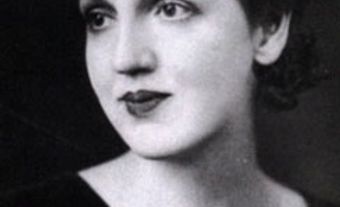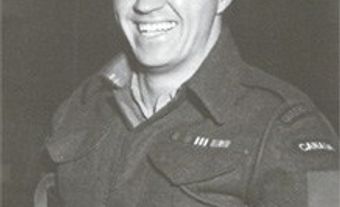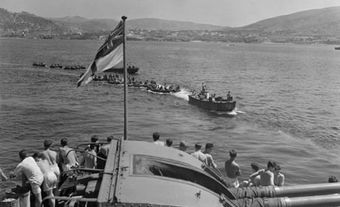This article was originally published in Maclean's Magazine on May 26, 2003
D-Day Vet's Memorial Centre Opens
GARTH WEBB recounts his fundraising odyssey with bemused fascination, as if luck had everything to do with it. But the story of how the D-Day vet generated $10 million to create a memorial and education centre celebrating Canada's contribution to the SECOND WORLD WAR belies his manner. After all, negotiating a land deal, choosing an architectural firm, overseeing the construction, developing the content and searching out an innovative curator took hard work and organization. As did hounding corporations, individuals and three levels of the French and Canadian governments for donations - all for a site 6,000 km away in the Normandy town of Courseulles-sur-Mer. In fact, it is clear that the man spearheading the Juno Beach Centre, which Jean Chrétien opens on June 6, the 59th anniversary of the D-Day invasion, has steered the venture from start to finish with verve and skill.
It seemed so simple at first. In 1996, having visited Juno Beach - the code name for the coastal area assigned to Canadian forces on D-Day - Webb, now 84, and his partner Lise Cooper realized Canadians lacked a "proper recognition" of their wartime role. "There was nothing to tell the story," he explains, "such as they do at Vimy." After discovering an attractive site in Bernières-sur-Mer, where three Canadian regiments landed, the couple began to hatch a plan. "We thought, this is a cinch," says the retired real-estate appraiser. "We'll buy this restaurant and Conrad Black or somebody will come along and take this thing over."
For a while, it was simple. Back home in Burlington, Ont., Webb, Cooper and two dozen veterans formed the Canada Normandy Association. An initial fundraising program drew lots of publicity: for $250, donors could buy a brick with a four-line inscription that would be featured in the then yet-to-be-built facility. When no philanthropist stepped up to the plate, they turned first to the federal government, landing $209,000. (Subsequent grants brought Ottawa's total to $3 million.) And, in 1998, the mayor of Bernières-sur-Mer offered them a prime beachfront property. They sealed the deal with champagne and a kiss. But after two years, the town council failed to ratify the mayor's offer. "They really didn't want us," says Webb. "They wanted an art gallery." Embattled but not defeated, Webb and his cohorts made another foray - this time successfully - into nearby Courseulles-sur-Mer, where Canadians became the first Allied troops to secure their D-Day objectives.
Meanwhile, in Canada, Webb's efforts continued to pay off. Walmart Canada came on board, raising $1.5 million - as, eventually, did four provinces and numerous municipal governments. He had a brief chat with Ernie Eves moments before the Ontario premier announced his support last fall. "I could see his speech over his shoulders," says Webb. "There was the amount we were expecting, $250,000, crossed out, with $1 million written on top. I couldn't believe it."
The fundraising feat, however impressive, is a distraction from Webb's real passion: getting the story of Canada and the Second World War out to later generations - and telling it from the veterans' point of view. The centre, Webb emphasizes, is not just about the Normandy invasion, but recounts what Canada was like at the time and all the significant naval, air force and land battles. A "children's circuit," in which a computer-generated boy and girl interact with visitors, mirrors the adult-oriented displays. And within a few weeks of the opening, kids in Canada will be able to access the site's content - and much more - on the Internet.
Despite his tremendous commitment, Webb insists he's not the best candidate to tell the D-Day story. He was a 25-year-old reinforcement officer with the 14th Field Regiment on June 6, 1944, when some 14,000 Canadians stormed the French coast. In charge of four six-men gun crews under heavy artillery fire, he had little time to consider his surroundings and reactions. Webb has no dramatic stories to recount, he says, because "I was too busy getting organized to see much." Then, as now, he was clearly playing his strong suit.
Maclean's May 26, 2003

 Share on Facebook
Share on Facebook Share on X
Share on X Share by Email
Share by Email Share on Google Classroom
Share on Google Classroom


